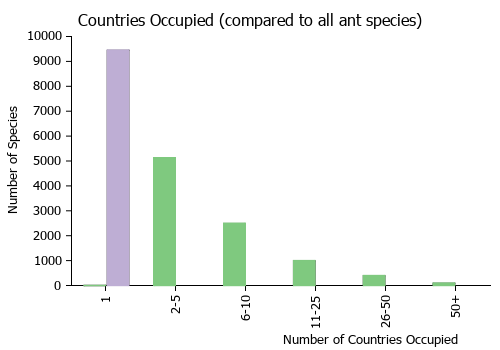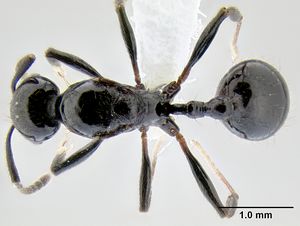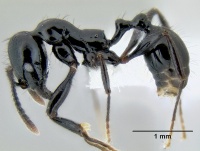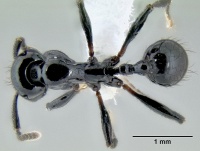Stenamma atribellum
| Stenamma atribellum | |
|---|---|

| |
| Scientific classification | |
| Kingdom: | Animalia |
| Phylum: | Arthropoda |
| Class: | Insecta |
| Order: | Hymenoptera |
| Family: | Formicidae |
| Subfamily: | Myrmicinae |
| Tribe: | Stenammini |
| Genus: | Stenamma |
| Species: | S. atribellum |
| Binomial name | |
| Stenamma atribellum Branstetter, 2013 | |
This species is a cloud forest specialist ranging from 1550–2030 m elevation, and is known from one leaf litter sample and one nest collection. The nest was collected underneath the bark of a large log in cloud forest near the edge of dwarf forest. The entire nest was not censused, but it was relatively large, with at least 100 workers, a single queen and brood.
Identification
Branstetter (2013) - Integument mostly black; medium- to large-sized species (see HL, ML, PrW below); gaster with elongate anterior constriction; entire body almost completely smooth and shiny, with only some faint carinulae and punctae; anterior clypeal margin with a median emargination; basal margin of mandible straight, without a basal notch or deep depression; eye relatively large (EL 0.16–0.20, REL 21–24), oval-shaped, with 9–10 ommatidia at greatest diameter; propodeal spines reduced to very small tubercles (PSL 0.10–0.13, PSI 0.9–1.0); gastral pilosity forming a layer of somewhat stout suberect setae, and a very sparse layer of short decumbent setae; frontal lobes of moderate width (FLD 0.19–0.22, FLI 24–26), not completely obscuring to- rular lobes in full-face view.
Stenamma atribellum is a distinctive species that should not be confused with any other Middle American clade Stenamma species. Stenamma callipygium is the only other Stenamma species to have an elongate anterior gastral constriction. Stenamma atribellum can be separated from S. callipygium by its completely smooth and shiny sculpture and emarginate anterior clypeal margin. Furthermore, these species have not been collected in sympatry and both appear to be narrow endemics. Stenamma atribellum might be confused with the superficially similar Stenamma alas and Stenamma expolitum, which are both mostly smooth and shiny. However, these latter species do not have the anterior constriction of the gaster elongate and they tend to have more facial sculpture (especially in S. alas). These species are also geographically separated from one another.
Keys including this Species
Distribution
Known only from the type locality in Parque Nacional Cusuco, Cortés, Honduras.
Latitudinal Distribution Pattern
Latitudinal Range: 15.5074° to 15.497°.
| North Temperate |
North Subtropical |
Tropical | South Subtropical |
South Temperate |
- Source: AntMaps
Distribution based on Regional Taxon Lists
Neotropical Region: Honduras (type locality).
Distribution based on AntMaps
Distribution based on AntWeb specimens
Check data from AntWeb
Countries Occupied
| Number of countries occupied by this species based on AntWiki Regional Taxon Lists. In general, fewer countries occupied indicates a narrower range, while more countries indicates a more widespread species. |

|
Estimated Abundance
| Relative abundance based on number of AntMaps records per species (this species within the purple bar). Fewer records (to the left) indicates a less abundant/encountered species while more records (to the right) indicates more abundant/encountered species. |

|
Biology
Castes
Males have not been collected.
Worker
Images from AntWeb
        
| |
| Worker. Specimen code casent0622351. Photographer Michael Branstetter, uploaded by Default Group. | Owned by MGBPC. |
Queen
Images from AntWeb
   
| |
| Paratype Stenamma atribellum. Queen (alate/dealate). Specimen code casent0622349. Photographer Michael Branstetter, uploaded by Default Group. | Owned by USNM. |
Nomenclature
The following information is derived from Barry Bolton's Online Catalogue of the Ants of the World.
- atribellum. Stenamma atribellum Branstetter, 2013: 52, figs. 52, 53 (w.q.) HONDURAS.
- Type-material: holotype worker, 15 paratype workers, 1 paratype queen.
- Type-locality: holotype Honduras: Cortés, Parque Nac. Cusuco, 15.50739°N, 88.23373°W±20m., 2030 m., 3.vi.2010, MGB1606 (M.G. Branstetter); paratypes with same data.
- Type-depositories: USNM (holotype); CASC, CFSS, EAPZ, FMNH, ICNB, INBC, JTLC, LACM, MCZC, MGBC, MZSP, UNAM, UCDC, USNM, UVGC (paratypes).
- Distribution: Honduras.
Unless otherwise noted the text for the remainder of this section is reported from the publication that includes the original description.
Description
Worker
(10 measured) HL 0.88–0.99 (0.94), HW 0.77–0.88 (0.86), FLD 0.19–0.22 (0.22), PCW 0.04–0.06 (0.04), SL 0.77–0.85 (0.83), EL 0.16–0.20 (0.18), ACL 0.66–0.71 (0.69), ML 1.19–1.32 (1.26), PrW 0.52–0.58 (0.55), PSL 0.10–0.13 (0.12), SDL 0.11–0.13 (0.11), PL 0.43–0.47 (0.45), PH 0.25–0.28 (0.27), PW 0.19–0.21 (0.20), PPL 0.27–0.31 (0.30), PPH 0.25–0.27 (0.26), PPW 0.25–0.28 (0.26), MFL 1.00–1.13 (1.08), MTL 0.77–0.87 (0.82), CI 87–92 (92), SI 94–101 (96), REL 21–24 (21), FLI 24–26 (25), PSI 0.9–1.0 (1.0), MFI 71–84 (80), ACI1 62–66 (63), ACI2 82–91 (83).
Medium- to large-sized species; general body color mostly black, with patches of dark brown; appendages black to orange-brown, lighter at extremities; setae dark brown; mandible with 6 teeth, but two teeth nearest basal tooth usually worn and indistinct; basal margin of mandible straight, without basal notch or deep depres- sion; mandible mostly smooth and shining, with scattered piligerous punctae; anterior clypeal margin with a median emargination; median lobe of clypeus smooth and shiny, lacking carinae, remainder of clypeus smooth and shiny; posterior ex- tension of clypeus between antennal insertions of moderate to wide width (PCW 0.04–0.06), sides slightly hourglass-shaped; frontal lobes of moderate width (FLD 0.19–022, FLI 24–26), not obscuring torular lobes in full-face view; head roughly oval-shaped, distinctly longer than broad (CI 87–92), with posterior margin slightly depressed medially; eye relatively large (EL 0.16–0.20, REL 21–24), roughly oval- shaped, with 9–10 ommatidia at greatest diameter; head almost completely smooth and shiny, with short faint longitudinal carinulae around midline of face near anten- nal lobes; scape relatively long (SI 94–101), just reaching posterior margin of head when laid back; scape surface smooth and shiny, except for scattered piligerous punctae; funiculus with a somewhat distinct antennal club; mesosoma almost completely smooth and shining, except for shallow furrows along metanotal grove, and scattered piligerous punctae; promesonotum in profile low-domed and asymmetrical, with the apex slightly anterior of midpoint; metanotal grove shallow, but distinct; propodeal spines reduced to small tubercles (PSL 0.10–0.13, PSI 0.9–1.0); petiole of moderate length (PL 0.43–0.47, PL/HW 0.52–0.57); petiolar node in profile nearly symmetrical, and of moderate height (PH/PL 0.57–0.60), dorsum smoothly rounded; postpetiole bulging and distinctly wider than petiole (PW/PPW 0.72–0.78), anterior face long and shield-like, posterior face short and truncate; petiole and postpetiole al- most completely smooth and shining, with some faint punctae confined mostly to the ventral surfaces; gaster with an elongate anterior constriction and with faint dorsal striae, remainder of gaster smooth and shiny, except for piligerous punctae; most of body dorsum with a layer of moderately long and stout standing pilosity; scape with suberect to decumbent setae; gaster with a layer of suberect setae, and a very sparse layer of short decumbent setae; legs with mostly appressed setae, but some suberect setae on coxae and femoral venters.
Queen
(1 measured) HL 0.99, HW 0.89, FLD 0.24, PCW 0.06, SL 0.85, EL 0.26, ACL 0.72, ML 1.53, PrW 0.83, PSL 0.16, SDL 0.15, PL 0.58, PH 0.34, PW 0.25, PPL 0.35, PPH 0.32, PPW 0.33, MFL 1.16, MTL 0.89, CI 90, SI 95, REL 29, FLI 27, PSI 1.1, MFI 77, ACI1 62, ACI2 85.
Same as worker except for standard queen modifications and as follows: face with a few distinct carinulae extending from frontal lobes to ocelli; mesoscutum, near posterior margin, and scutellum, with some longitudinal carinulae/rugulae.
Type Material
Holotype worker. HONDURAS: Cortés, Parque Nacional Cusuco, 15.50739°N, 88.23373°W ±20m, 2030m, 3 Jun 2010, cloud forest, nest under bark of log (M. G. Branstetter, collection MGB1606) USNM, specimen CASENT0622351]. Paratypes: same data as holotype 1w, CASC, CASENT0623237, 1w, EAPZ, CASENT0623238, 1w, ECOSCE, CASENT0623239, 1w, FMNH, CASENT0623240, 1w, ICN, CASENT0623241, 1w, INBC, CASENT0623242, 1w, JTLC, CASENT0623525, 1w, LACM, CASENT0623243, 1w, MGBPC, CASENT0623525, 1w, MCZ, CASENT0623244, 1w, MZSP, CASENT0623245, 1w, UCDC, CASENT0623246, 1w, UNAM, CASENT0623247, 1dq, 1w, USNM, CASENT0622349, 1w, UVGC, CASENT0623077.
Etymology
The specific epithet atribellum is derived from the greek words atri- and bellu- which roughly translate into black beast.
References
- Branstetter, M. G. 2012. Origin and diversification of the cryptic ant genus Stenamma Westwood (Hymenoptera: Formicidae), inferred from multilocus molecular data, biogeography and natural history. Systematic Entomology 37:478-496. doi:10.1111/j.1365-3113.2012.00624.x.
- Branstetter, M.G. 2013. Revision of the Middle American clade of the ant genus Stenamma Westwood (Hymenoptera, Formicidae, Myrmicinae). ZooKeys 295, 1–277. doi:10.3897/zookeys.295.4905
References based on Global Ant Biodiversity Informatics
- Branstetter M.G. 2013. Revision of the Middle American clade of the ant genus Stenamma Westwood (Hymenoptera, Formicidae, Myrmicinae). ZooKeys 295: 1277


